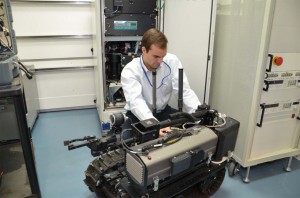The U.S. Army and General Motors Co. have teamed up on the development of hydrogen-powered fuel cell vehicles.
What may seem like an odd couple alliance actually reveals a common need for clean, alternatively powered vehicles that not only can run on public highways but potentially serve at remote military applications where access to petroleum-based fuels might be severely limited.
Fuel cells have often been referred to as “rechargeable batteries” because they provide a steady flow of current to drive electric motors. In contrast to conventional batteries which require long charging cycles, however, hydrogen tanks can be refueled in a matter of minutes.
“We believe hydrogen fuel cell technology holds tremendous potential to one day help reduce our dependence on petroleum and we are committed to building on our leadership through the continued development,” said Charlie Freese, executive director of GM’s global fuel cell engineering activities.
The U.S. Department of Defense has been a major source of financing for research and development in alternative powertrains over the past two decades because military planners believe electric vehicles offer more flexibility and utility in a hostile environment. EVs – and fuel cell vehicles, or FCVs – can run silently, providing a stealthy dimension that is prized by special operations forces, which handle some of the military’s most hazardous operations.
(GM, Honda form new fuel cell research alliance. Click Here for the details.)
FCVs also have a lower heat signature than conventionally powered vehicles, which could make them more difficult to spot by enemy combatants using night vision glasses and other heat-sensing devices.
In addition, the movement of petroleum products, primarily diesel fuel, requires an enormous commitment of resources to protect and transport in war zones. The movement of petroleum products during the wars in Iraq and Afghanistan has proven particularly costly for the U.S. – at times running to $100s a gallon in total logistic costs.
Automakers such as GM have also expressed a keen interest in fuel cells. In fact, Toyota plans to formally unveil a new fuel cell vehicle in November that it then plans to put into limited production by 2015.
(Toyota plans 300-mile range with new hydrogen fuel cell vehicle. Click Herefor more.)
The basic technology behind fuel cells has significantly improved in recent years but cost and high-volume manufacturability are still issues. Meanwhile, there is a lack of a hydrogen production, distribution and refueling infrastructure – though California has taken steps to get as many as 100 hydrogen stations into operation in the coming years, while German lawmakers plan to create a network of hydrogen stations across that country.
“Fuel cells always seem to be about 15 years away,” noted J. Ferron, who now oversees the annual Pace Awards handed out each year to carmakers and suppliers honoring their technological innovations.
(Audi developing hydrogen-powered version of A7. Click Here to learn more.)
Under the new program GM will team up with the U.S. Army Tank and Automotive Research and Development Center, or TARDEC, in Warren, Mi. to expand their collaboration in the development of hydrogen fuel cell technology.
Through a new Cooperative Research and Development Agreement, GM and TARDEC will jointly test new hydrogen fuel cell-related materials and designs to evaluate their performance and durability before assembling them into full scale fuel cell propulsion systems.
“The Army continues to investigate technologies and partnerships that give the United States a decisive advantage,” said TARDEC Director Paul Rogers. “Our relationships – like this one with GM – are maturing and accelerating technologies critical to the transportation and energy capabilities of the future.”
This is the second fuel cell-related announcement GM has made this year. In July, GM and Honda announced a long-term, definitive master agreement to co-develop a next-generation fuel cell system and hydrogen storage technologies, aiming for the 2020 time frame.
Paul A. Eisenstein contributed to this report.


IMO hydrogen fuel cells hold a lot of real promise and I for one look forward to the day when they become practical and affordable for the masses.